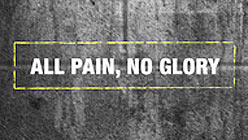Anyone who has flipped through cable TV channels knows there’s a viable audience for what could be called “the full spectrum of American society.” Hoarding? That’s the subject of TLC’s successful series Hoarding: Buried Alive. In-laws from hell? That’s the focus of AMC’s Monster In-Laws. And cage fighting? That’s on Showtime and other cable networks, though not under “cage fighting” but its more generic title, “Mixed Martial Arts.” Punching. Kicking. Scissoring an opponent’s head with your legs. All are allowed in a sport that has eclipsed boxing for televised popularity and is easy to typecast as a brutal endeavor with no real social value.
A new documentary, Fight Life, goes behind the scenes of mixed martial arts and both confirms the stereotypes (the sport is brutal) and parses out complexities that humanize the athletes and the athleticism that’s required to reach the profession’s pinnacle. Like any sport — like any profession — mixed martial arts rewards those who have a combination of talent/commitment/flair. Having a trying background may also be a plus, judging by two prominent fighters featured in Fight Life: Lyle “Fancy Pants” Beerbohm, a former meth addict who has spent time in jail; and Frank Shamrock (nee: Frank Alisio Juarez), a champion fighter and another former inmate, who tells filmmaker James Z. Feng, “I was abused as a kid. I was a ward of the state. I went to prison. I never really had anything. I never had something to look up to. Mixed martial arts was the right thing at the right time.”
Fight Life is screening Friday night at the Roxie Theater as part of the United Film Festival, and the film’s biggest presence is a San Francisco fighter, Jake Shields, who’s a vivid counterpoint to Frank Shamrock and Lyle Beerbohm. Well-spoken and from a seemingly untroubled family, Shields, 33, is a vegetarian who attended San Francisco State on a wrestling scholarship. He dotes on his young daughter. He seems, well, “normal,” if that word can be used in a sport whose professional matches are banned by the state of New York because of legislator concerns that mixed martial arts is overly violent. In the last 10 years, the sport’s promoters have implemented rules changes (no groin kicks, no head butts, etc.) that have coincided with its growing popularity and its sanctioning by the vast majority of state bodies.
Feng, who lives in San Francisco, practiced martial arts as kid. As a burgeoning documentarian who faced long odds to get Fight Life completed (Feng made it on a $60,000 budget that he mostly financed by himself), he can relate to the do-or-die attitude of the fighters he interviewed, who are paid very little money until they make a name for themselves, which can take years.



